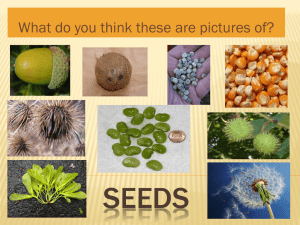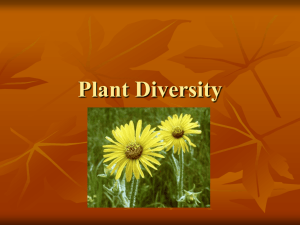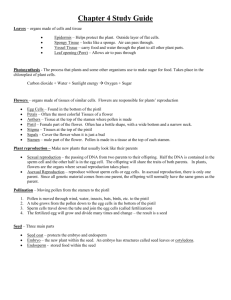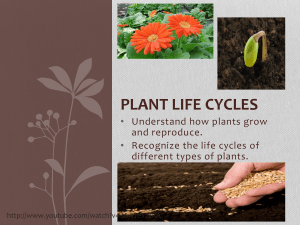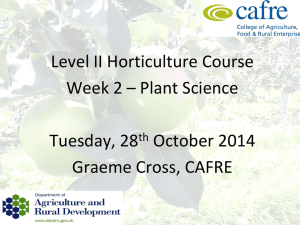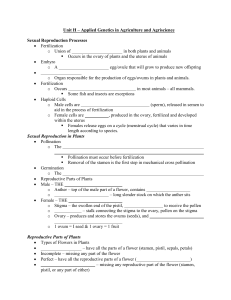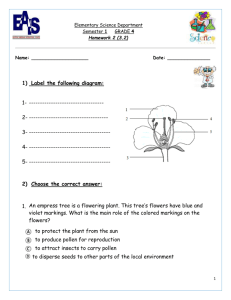Plants Study Guide 4.4
advertisement
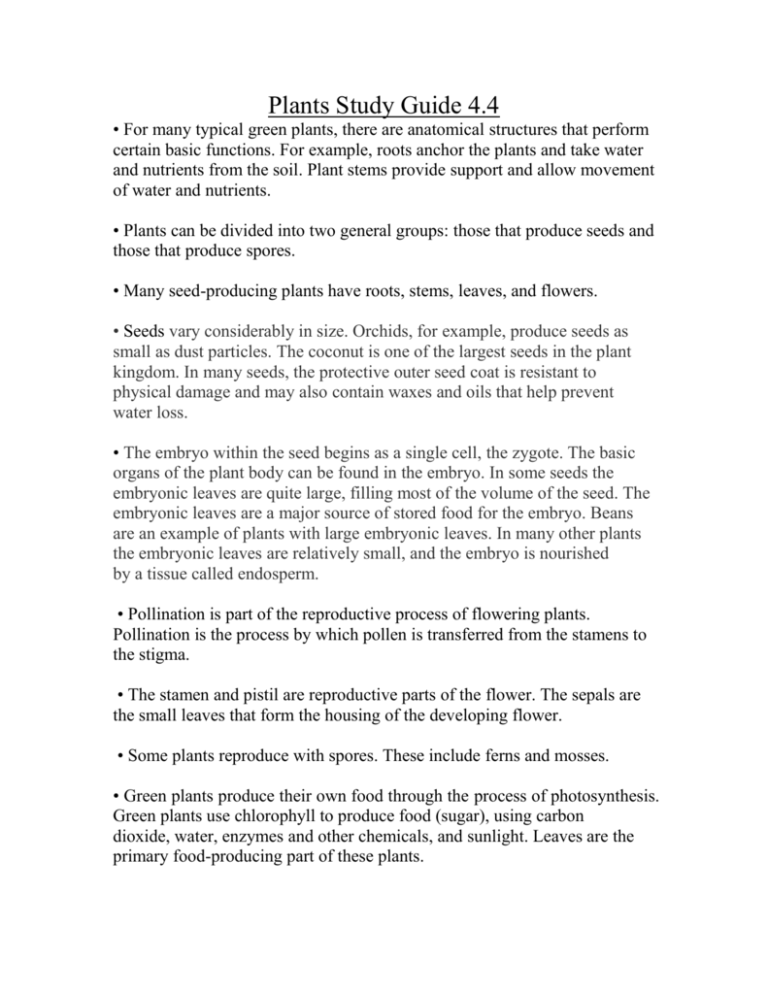
Plants Study Guide 4.4 • For many typical green plants, there are anatomical structures that perform certain basic functions. For example, roots anchor the plants and take water and nutrients from the soil. Plant stems provide support and allow movement of water and nutrients. • Plants can be divided into two general groups: those that produce seeds and those that produce spores. • Many seed-producing plants have roots, stems, leaves, and flowers. • Seeds vary considerably in size. Orchids, for example, produce seeds as small as dust particles. The coconut is one of the largest seeds in the plant kingdom. In many seeds, the protective outer seed coat is resistant to physical damage and may also contain waxes and oils that help prevent water loss. • The embryo within the seed begins as a single cell, the zygote. The basic organs of the plant body can be found in the embryo. In some seeds the embryonic leaves are quite large, filling most of the volume of the seed. The embryonic leaves are a major source of stored food for the embryo. Beans are an example of plants with large embryonic leaves. In many other plants the embryonic leaves are relatively small, and the embryo is nourished by a tissue called endosperm. • Pollination is part of the reproductive process of flowering plants. Pollination is the process by which pollen is transferred from the stamens to the stigma. • The stamen and pistil are reproductive parts of the flower. The sepals are the small leaves that form the housing of the developing flower. • Some plants reproduce with spores. These include ferns and mosses. • Green plants produce their own food through the process of photosynthesis. Green plants use chlorophyll to produce food (sugar), using carbon dioxide, water, enzymes and other chemicals, and sunlight. Leaves are the primary food-producing part of these plants. • Oxygen is released during photosynthesis. • Plants adapt to changes in their environment in order to survive. Dormancy is a plant adaptation. Dormancy is a period of suspended life processes brought on by changes in the environment. Plant Vocabulary Science Vocabulary anther – the pollen bearing part of a stamen (locate on diagram) chlorophyll – a green material in plant leaves that traps energy from sunlight and colors the plants chloroplast – the part of the flower that contains the chlorophyll cotyledon – a leaf-like structure of plants that appears during germination and is sometimes called a seed leaf dormancy – a period of suspended life processes brought on by changes in the environment (Dormancy is a plant adaptation.) embryo – the tiny part of the seed that can grow into a new plant germination – the process in which a plant begins to sprout or grow leaves – the primary food producing parts of green plants during photosynthesis ovary – the female organ that produces eggs; will eventually form the fruit (locate on diagram) ovule – will become the seed, or egg; located inside in he ovary (locate on diagram) petals – the flower parts with bright colors and smells that attract different animals for pollination (locate on diagram) photosynthesis – the way in which green plants trap the sun’s energy and use it to change carbon dioxide and water into sugars pistil – the female part of the flower (locate on diagram) pollen – the yellow, powdery substance found on the anther and used in pollination (locate on diagram) pollination – the moving of the pollen from the stamen to the pistil root – structures that anchor the plant and take water and nutrients from the soil seed – a young plant in a protective coat; embryo sepal – parts that protect the flower when it is a bud (locate on diagram) spore – cells in seedless plants that can grow into new plants stamen – male parts of the flower (locate on diagram) stem – the structure that provides support and allows the movement of water and nutrients to the plant stigma – the sticky, top part of the pistil (locate on diagram) zygote – After a female egg is fertilized, the resulting one-celled organism becomes known as a zygote. The italicized words above in the “ Science Vocabulary” section are for enrichment purposes. Parts of a Flower Big Idea Questions Big Idea Questions • Name the major parts of a plant, and discuss the role each part plays for the plant. • Name the major reproductive parts of a plant, and discuss the role each part plays for the plant’s reproductive process. • Describe the relationship of pollination to plant reproduction. • What role do you think seeds and flowers play in plant reproduction? • What are some different ways plants can be pollinated? • How is the way a fruit tree is pollinated different from the way a pine tree is pollinated? • Think about the reproduction process of most plants. How does the reproduction process for ferns and mosses compare to most plants? • Where do plants get the materials they use to make their own food? Explain how plants use these materials to make food. (process of photosynthesis) • How is the process of photosynthesis helpful to animals and humans? • Why is it important for plants to adapt to their environment? Explain two examples of how plants adapt to their environment. • How do we know a tree doesn’t die in the winter?


